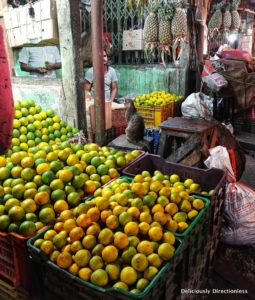
Every time I travel, I always try to take a walking tour with a local tour company. It could be a food walk in Rome or a neighbourhood jaunt in Madrid. But how often do we explore our own backyard? A few months ago, I had a friend visiting from Copenhagen so I signed us up for the Mumbai By Dawn tour offered by No Footprints.

No Footprints is an experiential travel company that offers several immersive tours in Mumbai. They have recently started walks in Delhi as well. I had heard about this particular tour from another friend and I was keen to check it out. So at 5 a.m. one November morning, I found myself at St Regis Mumbai (where my friend was staying). Here, we met Harshvardhan Tanwar, the founder of No Footprints. The three of us piled into an Innova and headed to the southern end of the city.
Fishy business

© No Footprints
Our first stop was Sassoon Docks, Mumbai’s first wet dock and the only one that is open to the public. We got the whiff of fish even before we reached the docks. Hundreds of fishing boats had lined up to unload the day’s catch. There were pomfret, kingfish, Indian salmon, tuna, Indian golden anchovy, mackerel, prawns, etc.

© No Footprints
Women rule the roost in the koli (fisherfolk) community, handling every aspect of the business from buying fish at the docks to selling it in markets around the city or from door-to-door. There were lively auctions going on to get the best price for the Bombay duck or bombil. Tanwar explained how the name Bombay duck came about; it’s an urban legend involving the fish, the railways, and the British.

© No Footprints

© No Footprints
Despite living in the city all my life, I hadn’t seen Mumbai by dawn quite like this. The cacophony of noises, the aggressive jostling of the fisherwomen, and the overhanging fishy smell are enough to jolt you awake! Note that you cannot take photographs at the docks. These images are courtesy of No Footprints who shot them with prior permission.
Daily news

When you pick up your newspaper every morning, you hardly give a thought to how it gets to you. But on the Mumbai by dawn tour, I got a glimpse into the logistics of it. From Sassoon Docks, we drove to Chhatrapati Shivaji Maharaj Terminus.

But instead of entering the station, we crossed the road to an innocuous footpath. Here, a few dozen men sat amidst piles of the day’s newspapers that had arrived fresh off the presses. There were newspapers in English, Marathi, Hindi, and several other Indian languages. This is one of the city’s largest newspaper distribution networks where (often illiterate) men sort out newspapers.


These are then carried off on bicycles to vendors across the area.

The footpath is not enough and the newspapers take over the street. The vendors rapidly sort them while sipping on chai from a tea stall nearby.

We too joined in for a ‘cutting’, a Mumbai tradition of having a half-cup of milky, sugary tea.
Market watch

Reinvigorated with the chai, we continued to Byculla Vegetable Market, which is the largest vegetable market in the city. Tanwar revealed a bit of little-known trivia. In 1906, the then 15-year-old Dr. B. R. Ambedkar married his first wife Ramabai (aged 9) in a simple ceremony inside the vegetable market!

Every morning fresh fruits and vegetables arrive at the market from all over the state (and beyond).




It’s a great place to find out what’s in season. In summer, the market is awash with mangoes from across India, while in winter leafy greens and various root vegetables dominate. Men bearing large wicker baskets weave in and out amongst the crowds. These are porters that one can hire to carry the shopping load.
Flower power
The tour continued from Byculla towards Dadar. On the way, Tanwar regaled us with stories of Mumbai’s textile mills as we passed by Lower Parel. The area was dotted with flourishing cotton mills that went defunct in the 70s and 80s. Now, of course, the old mill spaces house shopping malls, and massive housing and commercial real estate developments.

At Dadar, we stopped on the flyover bridge right above the Dadar Flower Market. I peeked over the bannister and saw an explosion of colour.

Hundreds of thousands of flowers of every imaginable colour were piled high in baskets. The bright orange and yellow marigolds caught my eye as did the red and pink roses. The white chrysanthemums and the fragrant rajnigandha provide the necessary contrast. We walked around the market dodging vendors, shoppers, and hundreds of commuters rushing to or from the Dadar railway station that’s next to the market.

There are flowers available in bulk, or in bouquets, or as garlands and other decorations. Apart from locally grown flowers, vendors also sell imported ones like peonies and tulips. And there’s some spirited bargaining all-round too as this is a wholesale and retail market combined.
Laundry service

The last stop on the tour was Dhobi Ghat at Mahalaxmi. We got a bird’s eye look at the open-air laundry from the specially constructed viewing platform on the flyover bridge of Mahalaxmi railway station. Every day, thousands of dhobis (washermen) scrub, flog, wash, and bleach clothes on rows of open concrete wash pens. More than 7000 dhobis wash more than 1 lakh clothes every single day. This includes everything from hotel and hospital linens to clothes from neighbourhood laundries.

We headed down the steps and walked through the maze of alleys that make up Dhobi Ghat. Over the years, many dhobis have installed large mechanical washing and drying machines. So the iconic imagery of them flogging clothes on stones has become somewhat rare.

© No Footprints
What endures though is the picture-perfect scene of thousands of clothes hanging to dry, separated by colours. Swathes of red in one spot, a batch of blues elsewhere, whites fluttering away in another section, and so on – it’s quite a sight!
Note that the Dhobi Ghat walk is ordinarily not included in the tour but can be arranged for a small additional fee. This is for the local guide who escorts you through the area.
Are you keen to explore Mumbai by dawn? Check out the details on No Footprints.
This article was commissioned by Vistara Magazine and a version of it appeared in their January 2020 issue; read it here.



Nice post Prachi, this is my second time on your blog and I have find something very Interesting on it. Thanks for your effort for providing Something Interesting. Keep share more!
Thanks, glad you liked it!